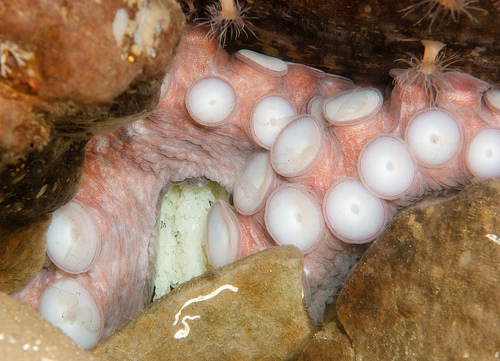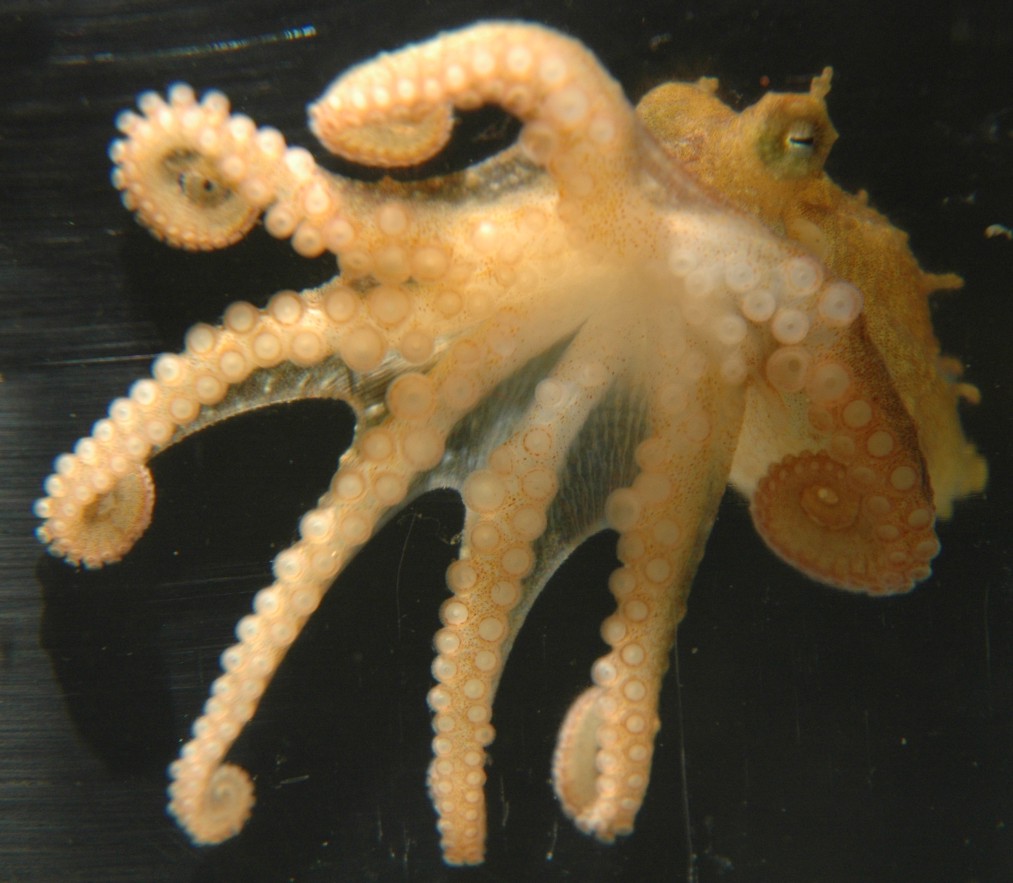Creating Pacific Octopuses
For
Enteroctopus dofleini,
reproduction is the ultimate purpose in life. Once this task is completed, it will die.
Before a courtship can begin between two octopuses,
they first need to find each other. It is believed that a male will
sense chemical attractants produced by a female and then search for
her.
During courtship both octopuses use their sense of
sight to determine attraction. Males are looking for a large female.
Larger diploid females produce more haploid eggs, by meiosis If more
eggs are fertilized, it gives the male a greater probability to pass
on his genes. Similarly, females are looking for a male with a large ligula.
The ligula is a portion of the male’s
hectocotylus and is located at the end of his arm. It contains
erectile tissue and will
become larger with attraction. To turn the
lady on, the male will flash
intricate skin displays with his
chromatophores. He will use her response to judge her
willingness and readiness to mate. Both males and females may have
more than one mate.
Sexual interactions occur between the Pacific octopuses
in two positions: side by side or with the male on top. The male
then ejects a haploid spermatophore, which was created by meiosis, from his ligula and
transfers it into his hectocotylus’s groove. Shockingly, the Pacific
octopus's spermatophores are about three feet long and contain up to
seven billion sperm! The spermatophore then proceeds to travel down the ciliated
groove of his hectocotylus, while the male places his arm into the female’s
mantle. He places the spermatophore into the female’s oviduct with
his ligula. It is unknown how the male is able to find her oviduct, but it
is believed she secretes chemicals to help him in this process. The
male’s ligula is also believed to be able to remove previous males’
spermatophores from within the female. During this sexual encounter, the male’s
heart skips a beat and the female’s respiration rate increases. The
Pacific octopus takes about an hour to pass a single spermatophore and the entire mating process, not including
courtship, takes about three to four hours, on average.

The female stores the sperm
within her their body, until
she is ready to lay the
eggs. When eggs travel out of the female's body, they travel past
the contained sperm and become fertilized. About 20,000
to 100,000 eggs, each the size of a grain of rice, will be
laid. She places these eggs along the wall of a chosen den. It will
take her a couple
of days to lay all of them. The peak time of year for egg-laying, or
spawning, is from April-May near Alaska and from May-July near
Japan. It takes about 150-230 days, about 6 or 7 months, for
the eggs to hatch. She will rarely leave the eggs during the entire
incubation period. During this time, the female will touch the eggs
with her arms and aerate them with her siphon. She does this to keep
them clean and free of fungi, bacteria and algae. After they hatch,
she will blow them out of the den and into the open ocean. (This can
be viewed in the video
above. I recommend watching at minute three.)
Upon hatching, the offspring immediately swim to the ocean's
surface. They will then experience a planktonic stage for about
30-90 days. Many of the octopuses die during this stage of life.
More information about this can be found
here.
The final stage of both the mating process and the
octopus’s life cycle is senescence. Both male and female Pacific
octopuses experience this dementia-like state of being. Males will
experience this alone, very soon after mating. Females, on the other
hand, will lay eggs and faithfully tend to them while going through
senescence.
During senescence, the octopuses refuse to
eat and will lose a lot of weight. The octopuses' bodies will
begin to metabolize
 muscle
because they do not store body
fat. One can lose up to 50% of its body weight. Also, males tend to move around in the open water without a
purpose. They do not hunt or forage, and rarely return to their
dens. This makes them easy prey. The last sign of senescence is the
appearance of white lesions on the skin. These lesions will not heal
because all of the octopus’s healing processes cease during
senescence. Infections are often a deadly side effect.
muscle
because they do not store body
fat. One can lose up to 50% of its body weight. Also, males tend to move around in the open water without a
purpose. They do not hunt or forage, and rarely return to their
dens. This makes them easy prey. The last sign of senescence is the
appearance of white lesions on the skin. These lesions will not heal
because all of the octopus’s healing processes cease during
senescence. Infections are often a deadly side effect.
The octopus experiences senescence until death, which usually arises from starvation or predation. The
females die almost immediately after the young hatch.
Back to Adaptations Forward to Interactions